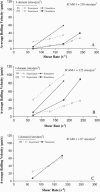I-domain of lymphocyte function-associated antigen-1 mediates rolling of polystyrene particles on ICAM-1 under flow
- PMID: 16100282
- PMCID: PMC1366851
- DOI: 10.1529/biophysj.104.057729
I-domain of lymphocyte function-associated antigen-1 mediates rolling of polystyrene particles on ICAM-1 under flow
Erratum in
- Biophys J. 2007 Jan 15;92(2):696
Abstract
In their active state, beta(2)-integrins, such as LFA-1, mediate the firm arrest of leukocytes by binding intercellular adhesion molecules (ICAMs) expressed on endothelium. Although the primary function of LFA-1 is assumed to be the ability to mediate firm adhesion, recent work has shown that LFA-1 can contribute to cell tethering and rolling under hydrodynamic flow, a role previously largely attributed to the selectins. The inserted (I) domain of LFA-1 has recently been crystallized in the wild-type (wt) and locked-open conformations and has been shown to, respectively, support rolling and firm adhesion under flow when expressed in alpha(L)beta(2) heterodimers or as isolated domains on cells. Here, we report results from cell-free adhesion assays where wt I-domain-coated polystyrene particles were allowed to interact with ICAM-1-coated surfaces in shear flow. We show that wt I-domain can independently mediate the capture of particles from flow and support their rolling on ICAM-1 surfaces in a manner similar to how carbohydrate-selectin interactions mediate rolling. Adhesion is specific and blocked by appropriate antibodies. We also show that the rolling velocity of I-domain-coated particles depends on the wall shear stress in flow chamber, I-domain site density on microsphere surfaces, and ICAM-1 site density on substrate surfaces. Furthermore, we show that rolling is less sensitive to wall shear stress and ICAM-1 substrate density at high density of I-domain on the microsphere surface. Computer simulations using adhesive dynamics can recreate bead rolling dynamics and show that the mechanochemical properties of ICAM-1-I-domain interactions are similar to those of carbohydrate-selectin interactions. Understanding the biophysics of adhesion mediated by the I-domain of LFA-1 can elucidate the complex roles this integrin plays in leukocyte adhesion in inflammation.
Figures








Similar articles
-
Interplay between rolling and firm adhesion elucidated with a cell-free system engineered with two distinct receptor-ligand pairs.Biophys J. 2003 Oct;85(4):2720-31. doi: 10.1016/S0006-3495(03)74695-5. Biophys J. 2003. PMID: 14507735 Free PMC article.
-
Transition from rolling to firm adhesion is regulated by the conformation of the I domain of the integrin lymphocyte function-associated antigen-1.J Biol Chem. 2002 Dec 27;277(52):50255-62. doi: 10.1074/jbc.M209822200. Epub 2002 Oct 3. J Biol Chem. 2002. PMID: 12368274
-
Rolling adhesion of alphaL I domain mutants decorrelated from binding affinity.J Mol Biol. 2006 Jun 30;360(1):37-44. doi: 10.1016/j.jmb.2006.04.049. Epub 2006 May 9. J Mol Biol. 2006. PMID: 16813834
-
Endothelial adhesion molecules and their role in inflammation.Can J Physiol Pharmacol. 1993 Jan;71(1):76-87. doi: 10.1139/y93-012. Can J Physiol Pharmacol. 1993. PMID: 8513436 Review.
-
Integrin inside-out signaling and the immunological synapse.Curr Opin Cell Biol. 2012 Feb;24(1):107-15. doi: 10.1016/j.ceb.2011.10.004. Epub 2011 Nov 28. Curr Opin Cell Biol. 2012. PMID: 22129583 Free PMC article. Review.
Cited by
-
Nanocarrier Hydrodynamics and Binding in Targeted Drug Delivery: Challenges in Numerical Modeling and Experimental Validation.J Nanotechnol Eng Med. 2013 Feb;4(1):101011-1010115. doi: 10.1115/1.4024004. Epub 2013 Jul 11. J Nanotechnol Eng Med. 2013. PMID: 23917383 Free PMC article. Review.
-
The Role of Glycocalyx in Nanocarrier-Cell Adhesion Investigated Using a Thermodynamic Model and Monte Carlo Simulations.J Phys Chem C Nanomater Interfaces. 2007 Nov 1;111(43):15848-15856. doi: 10.1021/jp074514x. J Phys Chem C Nanomater Interfaces. 2007. PMID: 19081797 Free PMC article.
-
Shear-regulated uptake of nanoparticles by endothelial cells and development of endothelial-targeting nanoparticles.J Biomed Mater Res A. 2010 Jun 1;93(3):833-42. doi: 10.1002/jbm.a.32592. J Biomed Mater Res A. 2010. PMID: 19653303 Free PMC article.
-
Dynamic factors controlling targeting nanocarriers to vascular endothelium.Curr Drug Metab. 2012 Jan;13(1):70-81. doi: 10.2174/138920012798356916. Curr Drug Metab. 2012. PMID: 22292809 Free PMC article. Review.
-
New biotechnological and nanomedicine strategies for treatment of lysosomal storage disorders.Wiley Interdiscip Rev Nanomed Nanobiotechnol. 2010 Mar-Apr;2(2):189-204. doi: 10.1002/wnan.73. Wiley Interdiscip Rev Nanomed Nanobiotechnol. 2010. PMID: 20112244 Free PMC article. Review.
References
-
- Springer, T. A. 1994. Traffic signals for lymphocyte recirculation and leukocyte emigration: the multistep paradigm. Cell. 76:301–314. - PubMed
-
- Lawrence, M. B., and T. A. Springer. 1991. Leukocytes roll on a selectin at physiologic flow rates: distinction from and prerequisite for adhesion through integrins. Cell. 65:859–873. - PubMed
-
- Tonnesen, M. G. 1989. Neutrophil-endothelial cell interactions: mechanisms of neutrophil adherence to vascular endothelium. J. Invest. Dermatol. 93:53S–58S. - PubMed
-
- Gopalan, P. K., C. W. Smith, H. Lu, E. L. Berg, L. V. McIntire, and S. I. Simon. 1997. Neutrophil CD18-dependent arrest on intercellular adhesion molecule 1 (ICAM-1) in shear flow can be activated through L-selectin. J. Immunol. 158:367–375. - PubMed
-
- Stewart, M. P., C. Cabanas, and N. Hogg. 1996. T cell adhesion to intercellular adhesion molecule-1 (ICAM-1) is controlled by cell spreading and the activation of integrin LFA-1. J. Immunol. 156:1810–1817. - PubMed
Publication types
MeSH terms
Substances
Grants and funding
LinkOut - more resources
Full Text Sources
Miscellaneous

